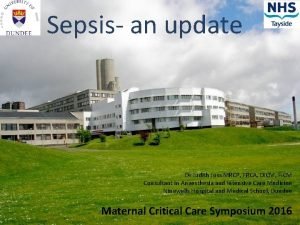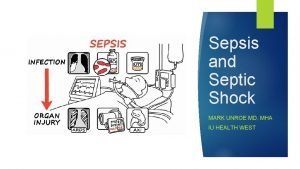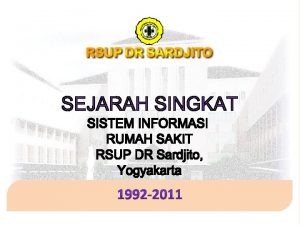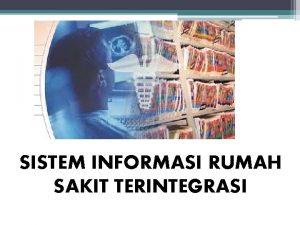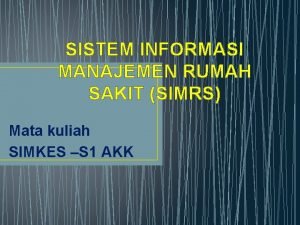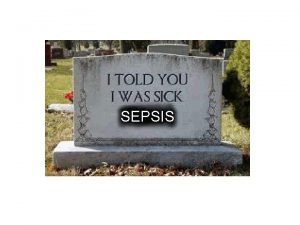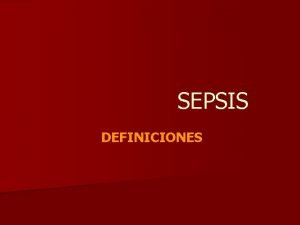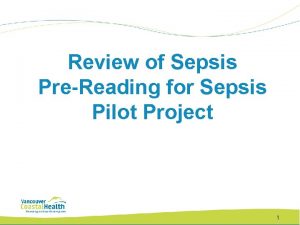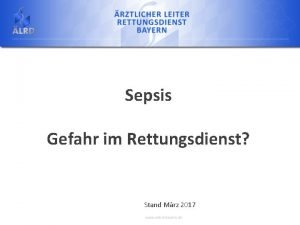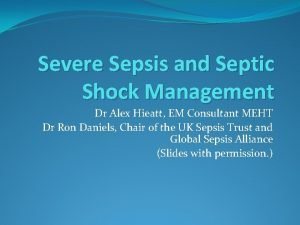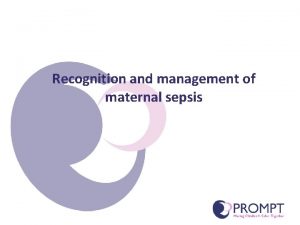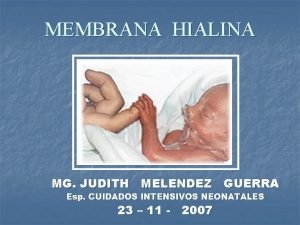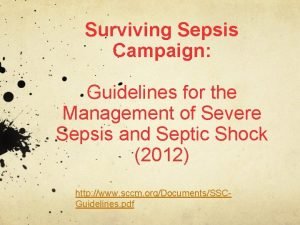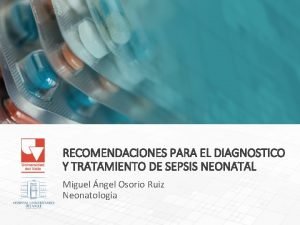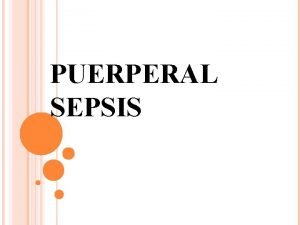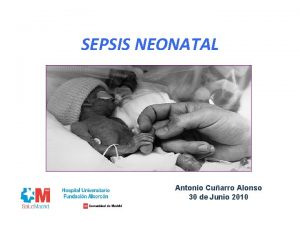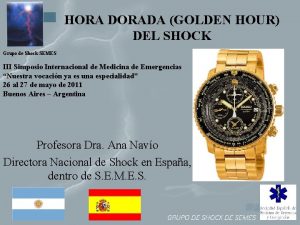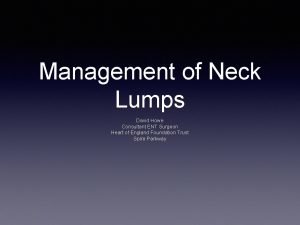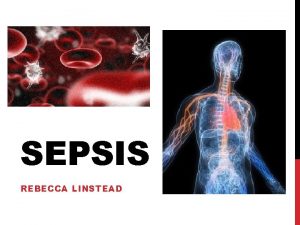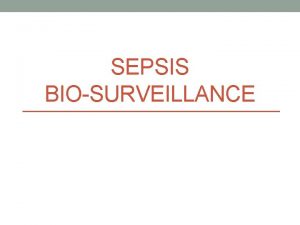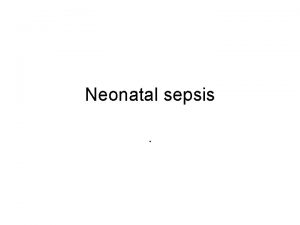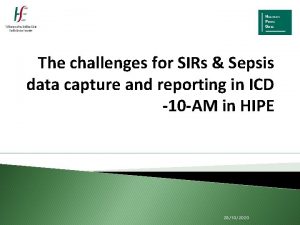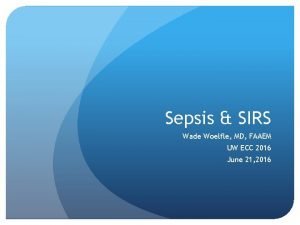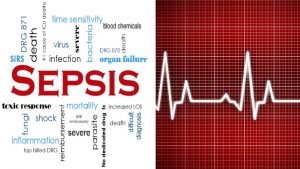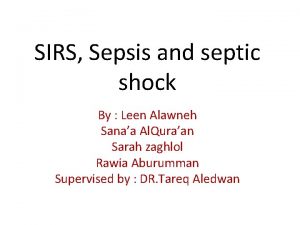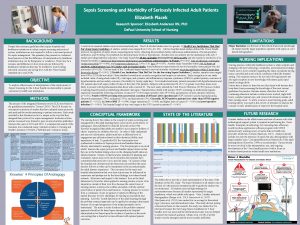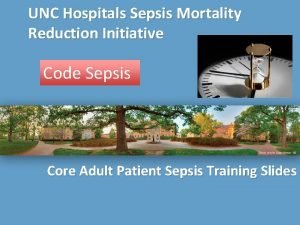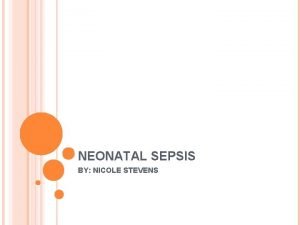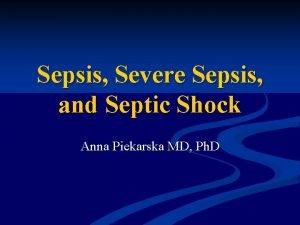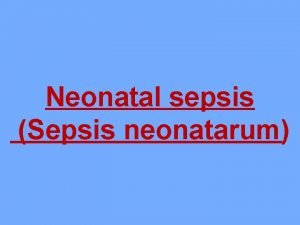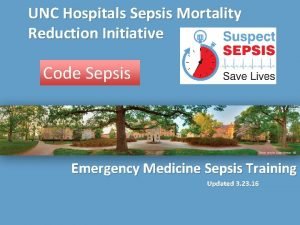Sepsis Definitions of infected states SIRS is the


































- Slides: 34

Sepsis

Definitions of infected states • ■ SIRS= is the body’s systemic response to severe infection • ■Multiple Organ Dysfunction Syndrome = is the effect that SIRS produces systemically , >= 2 organ failure

Definitions of infected states • ■ Multiple System Organ Failure (MSOF)= is the end stage of uncontrolled MODS • ■ Bacteremia: viable bacteria in the blood • ■ Septicemia: is a serious bloodstream infection, It’s also known as blood poisoning

systemic inflammatory response syndrome international Sepsis Definitions Conference systemic inflammatory response syndrome (SIRS) ≥ 2 of 1 - temperature > 38. 3 degrees C (100. 9 degrees F) or < 36 degrees C (96. 8 degrees F) 2 - heart rate > 90 beats/minute 3 - respiratory rate > 20 breaths/minute or arterial partial pressure of carbon dioxide (Pa. CO 2) < 32 mm Hg 4 - white blood cell count (WBC) > 12, 000/mm 3 or WBC < 4, 000/mm 3 or > 10% immature neutrophils (bands) above abnormalities should represent change from baseline without other known cause (such as leukopenia due to chemotherapy)

Definition • Sepsis is a serious problem from an infection. It is an overreaction of the body to the infection. It can lead to life-threatening organ damage • sepsis - SIRS due to documented or suspected infection

Severe sepsis • Severe sepsis - sepsis plus evidence of acute organ dysfunction or tissue hypoperfusion (any of below occurring due to infection) – sepsis-induced hypotension defined as 1 of • systolic blood pressure < 90 mm Hg • mean arterial pressure < 70 mm Hg • systolic blood pressure decrease > 40 mm Hg • in absence of other causes of hypotension

Septic shock • septic shock # clinically defined as persistent hypotension requiring vasopressors to maintain mean arterial pressure (MAP) ≥ 65 mm Hg and serum lactate level ≥ 2 mmol/L (18 mg/d. L) despite adequate volume resuscitation # associated with hospital mortality ≥ 40%

Pathophysiology • if there is some infective material in the bloodstream >> WBC will encounter this infective material >> WBC become active • 1) WBC recruitment • 2) WBC release NO >> dilate BV >> increase diameter & decrease the systemic vascular resistence (SVR) • 3) increase permeability of the blood vessel

Pathophysiology • # NOTE: You have the infecious material in the blood vessels all throughout the body. So, the vasodilation happen everywhere >> systemic vascular dilatation. Decreased SVR >> decreased Blood pressure. • 4) low tissue perfusion due to 1 - decreased BP 2 - difficulty to get to the cells ( due to increased leakiness) So the cells become starved of O 2.

Pathophysiology • 5) releasing lytic enzymes and Reactive oxygen species (ROS )to destroying the infective material, that may damage BV as well so… several complications can occur >> damage to endothelium triggers coagulation cascade causing micro-clot of : - fibrin, neutrophils, platelets, RBCs. >> formation of “micro clot” that my: • prevents BV rupture >> so blood does not spill into extravascular space

Pathophysiology • Also, there is coagulation happens in the vascular system (disseminated intravascular coagulation -DIC-) >>>>> this mechanisms can not keep up the breakage of BV. (due to depletion in platlet, fibrin and other factors)…… So>> blood spilling out of BV >> simultaneous bleeding • • poor nutrition • • Poor O 2 delivary. • • Poor perfusion of vital organs.

Pathophysiology • 6) Cardiac output: initially increase to compensate BP >> ( increased CO* inc SVR = normal compensated BP) • • As septic shock goes on, the heart can become paralyzed and damage by these immune molecules so cardiac output start to be depressed >> so decreased CO * Decreased SVR >> decreased BP.

Pathophysiology • Acid base disturbances: ** Lactic acid is elevated due to tissue ischemia (acidosis) ** Acidosis + cytokines: tachypnea (develops due to acidocis, cytokines, and fever) which will lead to respiratory alkalosis ** Metabolic acidosis develops just before or with hypotension; it signals the beginning of a fatal downward course Cytokines involves in sepsis: TNF-alpha IL-1, 6, 8 Complement Coagulation pathways Gamma interpheron

Causes • a. Infectious —m. c=TB and other mycobacterial infection, Occult abscesses (e. g. , hepatic, retroperitoneal) UTI/complicated , UTI, Endocarditis Sinusitis HIV, Infectious mononucleosis, and , Malaria parasite , Infection of the digestive system (which includes organs such as the stomach and colon) • Infection of the kidney, bladder and other parts of the urinary system

Causes - Cellulitis , apendicitis , peritonitis infection of brain or spinal cord -immunosuppressive drugs, -chemotherapy) invasive lines (venous line or arterial ), - urinary catheters. . . etc. �Non-infectious: pancreatitis

• Risk Factors for sepsis Weakened immune system from illness or medical treatment Age under 1 year Age 65 years or more • HIV, diabetes, cancer, kidney or liver disease

Clinical Features • Fever (first and m. c manifestation)or may hypothermic ( more common in very young, elderly, immunocompromised …. ) • 2. sign of SIRS (tachypnea , tachycardia )……. . ( TACHYCARDIA is the 1 st manifestation) • 3. sign of shock ( hypotension, oliguria, lactic acidosis) ------ (hypotension and hypoxia) • 4. manifestation related to the cause of sepsis. ( e. g pneumonia / breathing difficulty, UTI / urination problem. . . ) • 5. flushing, warm skin due to BV dilatation ------ increase sympathetic innervation >> tries to increase BP by vasoconstriction to improve Systemic vascular resistance ------ so, with progression of septic shock, patient will eventually have cooler skin.

Diagnosis • 1. Careful history and physical examination—with attention to medications, travel, immune system competency, and review of systems • 2. Laboratory tests a. CBC with differential b. Urinalysis c. Cultures of blood, sputum, CSF, urine, and stool when indicated by clinical

Diagnosis • ABG, chemistry • o DIC work up by the following tests: - CBC –platelets are low. - PT–prolonged as coagulation factors are consumed – PTT– may be prolonged - D-dimer –protein that results from clot breakdown; it is markedly elevated with DIC -Fibrinogen – one of the clotting factors; is low

sofa score = Sequential (sepsisrelated) organ failure assessment score • previously known as the sepsis related organ failure assessment score, is used to track a person's status during the stay in an intensive care unit (ICU) to determine the extent of a person's organ function or rate of failure.



Sofa Score • A change in the SOFA score of 2 or more is now a defining characteristic of the sepsis syndrome, and the European Medicines Agency has accepted that a change in the SOFA score is an acceptable surrogate marker of efficacy in exploratory trials of novel therapeutic agents in sepsis. • The requirement to detect modest serial changes in a patients’ SOFA score therefore means that increased clarity on how the score should be assessed in different circumstances is required

quick. SOFA • The q. SOFA score = quick. SOFA) is a bedside prompt that may identify patients with suspected infection who are at greater risk for a poor outcome outside the intensive care unit (ICU). • It uses three criteria, assigning one point for Ø low blood pressure (SBP≤ 100 mm. Hg), Ø high respiratory rate (≥ 22 breaths per min), Ø or altered mentation (Glasgow coma scale<15).

quick. SOFA • The presence of 2 or more q. SOFA points near the onset of infection was associated with a greater risk of death or prolonged intensive care unit stay. • These are outcomes that are more common in infected patients who may be septic than those with uncomplicated infection. • Two points is a positive q. SOFA, with increasing points patient outcomes are associated with higher mortality rates • Based upon these findings, the Third International Consensus Definitions for Sepsis recommends q. SOFA as a simple prompt to identify infected patients outside the ICU who are likely to be septic.

TRIAGE of Sepsis At Emer. Gency department (TRIAGE) • Emergency departments play a vital role in identifying, treating, and managing septic patients. • Early identification and appropriate management in the initial hours after sepsis develops improves outcomes, . • SIRS and q. SOFA, are sepsis recognition tools =triage screening tool.

TRIAGE of Sepsis At Emer. Gency department (TRIAGE) • Randomized control trials or meta-analysis strengthen the claim for SIRS over q. SOFA in ED triage screening tool for sepsis recognition. • SIRS criteria has greatest sensitivity to sepsis recognition , , with q. SOFA showing higher sensitivity to mortality. • . The evidence leads to septic patients benefiting from an additional screening tool, the q. SOFA, if they have 2+ SIRS criteria to rule out higher mortality and critical care need. • A triage model at the ED with special attention to severe sepsis patients, led to sustained improvements

Treatment ABCs • 2 large IV bore • Fluid resuscitation (IV fluids at a dose of 30 m. L/kg given within the first 3 h) • oxygen • Empiric antibiotics, � Levofloxacin used in suspected patient with pneumonia since its cover most � Aminoglycosides(eg. Gentamycin), Ceftriaxone in UTI suspected � Ampicillin, Amoxicillin, Tetracyclines � Vancomycin For MRSA >>> After the culture result >> specific antibiotic to the organism. • if not get better with antibiotics>> Antifungal (for candidemia) • Vasopressors as needed as following:

Treatment • • Steroids: they are given for patients who develop adrenal insufficiency. • # monitor progress of the patient • 1) CRP(c- reactive protein) � normal < 1 mg/d. L • 2) ESR (erythrocyte sedimentation rate � normal < 20 -25 ml/h • **Both markers increased in inflammation and downtrend(decrease) in resolution of septic shock

Treatment • sodium bicarbonate may reduce need for renal replacement therapy in patients admitted to intensive care unit with severe acidemia • 2 JUN 2020 • vasopressin and vasopressin analogues might reduce need for renal replacement therapy compared to norepinephrine in critically ill adults with septic shock.

Treatment • • ABC 2 IV large bore giving antibiotics giving fluids intravenously giving oxygen if levels are low blood transfusion mechanical ventilation Dialysis Admission to ICU , --- corticosteroids medication ? ? ?

Sepsis Treatment in Adults, Dynamed , corticosteroids ? ? ? • treatment bundle of hydrocortisone, ascorbic acid, and thiamine may reduce time to resolution of shock in adults with sepsis or septic shock admitted to intensive care • 21 FEB 2020 • corticosteroids may increase shock reversal and reduce 28 -day mortality in patients with sepsis, with mortality benefit potentially limited to those with ARDS, communityacquired pneumonia, or septic shock • corticosteroids may reduce 28 -day mortality, ICU mortality, and hospital mortality in adults

Corticosteroids ? ? • Upon study was done in December 2018 - Maria Vargas, MD, Giuseppe Servillo, MD, Department of Neurosciences, Reproductive and Odontostomatological Sciences, University of Naples • And they found that the , results may suggest that the evidences about the relationship between the use of corticosteroids and the reduction of mortality in septic critically ill patients are very weak, and the messages coming from these randomized clincal trial RCTs), -- concluded that corticosteroid may result in a small absolute reduction in mortality of approximately 2%--, should be carefully interpreted. • Furthermore, they found no effect of corticosteroid on short-term mortality

• • Reference for SOFA score =Lambden, S , et al , The SOFA score—development, utility and challenges of accurate assessment in clinical trials, 23, Article number: 374 (2019) Reference For triage =November 2018. Triage Tool for Sepsis Recognition. [online]. Available from: https: //nursinganswers. net/essays/sepsis-triage-tool. php? vref=1 [Accessed 23 August 2020].
 Escala qsofa
Escala qsofa Sepsis 2 vs sepsis 3
Sepsis 2 vs sepsis 3 Mp under microscope
Mp under microscope Malodorous lochia
Malodorous lochia Psychological adaptation in postpartum
Psychological adaptation in postpartum Use of varnish is contraindicated under
Use of varnish is contraindicated under Lochia smell
Lochia smell Bimanual compression
Bimanual compression Sirs mandiri
Sirs mandiri Metode pengembangan sirs
Metode pengembangan sirs Sirs sepsa
Sirs sepsa Pengertian sistem informasi rumah sakit
Pengertian sistem informasi rumah sakit Sisrute.kemkes.go.ig
Sisrute.kemkes.go.ig What must
What must Sirs criteria
Sirs criteria Sirs 2021
Sirs 2021 Sirs criterios
Sirs criterios Sirs discoverer
Sirs discoverer Southern states of america
Southern states of america Checks and balances dbq
Checks and balances dbq What were the 11 free states
What were the 11 free states Stages of sepsis
Stages of sepsis Sepsis definition
Sepsis definition Dr alex sepsis
Dr alex sepsis Maternal sepsis
Maternal sepsis Sepsis
Sepsis Sepsis pp respiratorio
Sepsis pp respiratorio Surviving sepsis definition
Surviving sepsis definition Sepsis bundle
Sepsis bundle Sepsis neonatal temprana y tardía
Sepsis neonatal temprana y tardía Puerperal sepsis meaning
Puerperal sepsis meaning Antonio cuñarro alonso
Antonio cuñarro alonso Neonatal sepsis symptoms
Neonatal sepsis symptoms Golden hour medicina
Golden hour medicina Template
Template
